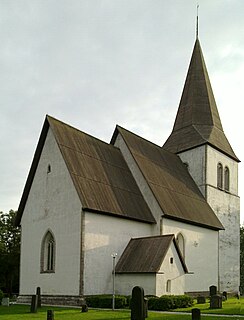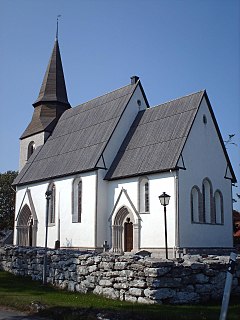Related Research Articles

Romanesque architecture is an architectural style of medieval Europe characterized by semi-circular arches. There is no consensus for the beginning date of the Romanesque style, with proposals ranging from the 6th to the 11th century, this later date being the most commonly held. In the 12th century it developed into the Gothic style, marked by pointed arches. Examples of Romanesque architecture can be found across the continent, making it the first pan-European architectural style since Imperial Roman architecture. The Romanesque style in England is traditionally referred to as Norman architecture.

Medieval architecture is architecture common in the Middle Ages, and includes religious, civil, and military buildings. Styles include pre-Romanesque, Romanesque, and Gothic. While most of the surviving medieval architecture is to be seen in churches and castles, examples of civic and domestic architecture can be found throughout Europe, in manor houses, town halls, almshouses, bridges, and residential houses.

The term Norman architecture is used to categorise styles of Romanesque architecture developed by the Normans in the various lands under their dominion or influence in the 11th and 12th centuries. In particular the term is traditionally used for English Romanesque architecture. The Normans introduced large numbers of castles and fortifications including Norman keeps, and at the same time monasteries, abbeys, churches and cathedrals, in a style characterised by the usual Romanesque rounded arches and especially massive proportions compared to other regional variations of the style.

Caen stone, is a light creamy-yellow Jurassic limestone quarried in north-western France near the city of Caen. The limestone is a fine grained oolitic limestone formed in shallow water lagoons in the Bathonian Age about 167 million years ago. The stone is homogeneous, and therefore suitable for carving.

Pre-Romanesque art and architecture is the period in European art from either the emergence of the Merovingian kingdom in about AD 500 or from the Carolingian Renaissance in the late 8th century, to the beginning of the 11th century Romanesque period. The term is generally used in English only for architecture and monumental sculpture, but here all the arts of the period are briefly described.

Pratovecchio Stia is a comune in the province of Arezzo, Tuscany. It was formed by the merger of the two former comuni of Pratovecchio and Stia in 2014.

Romanesque art is the art of Europe from approximately 1000 AD to the rise of the Gothic style in the 12th century, or later, depending on region. The preceding period is known as the Pre-Romanesque period. The term was invented by 19th-century art historians, especially for Romanesque architecture, which retained many basic features of Roman architectural style – most notably round-headed arches, but also barrel vaults, apses, and acanthus-leaf decoration – but had also developed many very different characteristics. In Southern France, Spain and Italy there was an architectural continuity with the Late Antique, but the Romanesque style was the first style to spread across the whole of Catholic Europe, from Sicily to Scandinavia. Romanesque art was also greatly influenced by Byzantine art, especially in painting, and by the anti-classical energy of the decoration of the Insular art of the British Isles. From these elements was forged a highly innovative and coherent style.

Sermoneta is a hill town and comune in the province of Latina (Lazio), central Italy.

The Monastery of Rates was a Benedictine monastery located in the parish of Rates in the municipality of Póvoa de Varzim, in Portugal. The part of the monastery that has survived to this day is the bell-tower and, most importantly, the Church dedicated to St Peter of Rates, mostly known as Romanesque Church of Rates, which is a national monument since 1910. Reconstruction of the church began at the turn of the 11th to the 12th century, turning it into one of the oldest extant Romanesque churches in Portugal.

The Abbey Church of Saint-Savin-sur-Gartempe is a Roman Catholic church located in Saint-Savin-sur-Gartempe, in Poitou, France.

Bro Church is a medieval era Lutheran church at Bro on the Swedish island of Gotland. The church belongs to the Väskinde parish in the Diocese of Visby of the Church of Sweden.

Bunge Church is a medieval Lutheran church in Bunge on the Swedish island of Gotland, in the Diocese of Visby (Sweden).

Stenkyrka Church is a medieval Lutheran church in Stenkyrka on the Swedish island of Gotland. It belongs to the Diocese of Visby.

Hemse Church is a medieval Lutheran church in Hemse on the island of Gotland, in the Diocese of Visby (Sweden).

Etelmhem Church is a medieval Lutheran church on the Swedish island of Gotland. It belongs in the Diocese of Visby of the Church of Sweden.

Endre Church is a medieval Lutheran church in Endre on the Swedish island of Gotland, in the Diocese of Visby. It was first built and consecrated as a Catholic church, but then taken for Lutheran worship at the reformation in the 16th century.

Fole Church is a medieval Lutheran church in Fole on the Swedish island of Gotland, in the Diocese of Visby.

Norrlanda Church is a medieval Lutheran church on the Swedish island Gotland, in the Diocese of Visby.

Gerum Church is a medieval Lutheran church in Gerum on the Swedish island of Gotland, in the Diocese of Visby.
The Collegiate Church of Santa Maria Assunta is a Gothic church located in Sermoneta, southern Lazio, Italy. The church is often referred to as a cathedral ("cattedrale") but has never been the seat of a bishop. It is dedicated to the Assumption of the Virgin Mary.
References
- ↑ Comune of Sermoneta, short entry.